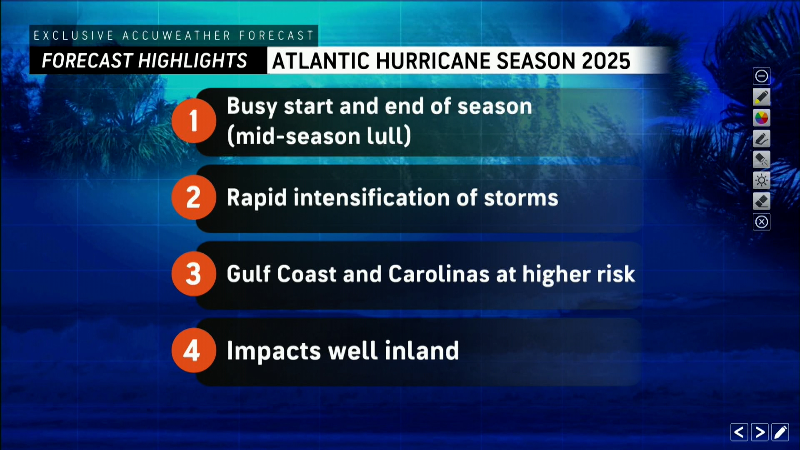Major climate pattern shifts ahead of hurricane season, bringing new risks

- La Niña conditions have ended, transitioning to a neutral phase, which historically has produced both active and quiet hurricane seasons.
- Neutral conditions typically favor Atlantic hurricane development due to lower wind shear, but "warm neutral" conditions can slightly decrease activity.
- Regardless of seasonal forecasts, individuals should prepare for potential hurricanes, as even less active seasons can produce powerful storms.
Hurricane forecasters are carefully watching ocean temperatures in the Pacific Ocean for changes that signal El Niño or La Niña, major global climate patterns that affect hurricane season outlooks.
On Thursday they announced La Niña conditions had ended after just 3 months, and a neutral period had begun — a scenario that has fed both devastating and mild hurricane seasons in the past.
La Niña, a natural climate pattern, is marked by cooler-than-average seawater in the central and eastern Pacific Ocean, and is part of the El Niño – Southern Oscillation (ENSO) cycle, which can significantly impact weather patterns globally, especially during late fall, winter, and early spring. La Niña also acts to boost Atlantic hurricane activity.
Its opposite is El Niño, which is a natural climate pattern where sea surface temperatures in the central and eastern tropical Pacific Ocean are warmer than average, occurring roughly every 2-7 years, and also part of the broader ENSO cycle. El Niño typically diminishes Atlantic hurricane activity.
A top hurricane forecast brings bad news: Danger is already brewing
ENSO-neutral is an intermediate phase between El Niño and La Niña when water temperatures are neither unusually cold or warm.
What happened to La Niña?
A weak but drought-spawning La Niña officially came to an end this week, federal climate forecasters announced Thursday morning. In its immediate place will be so-called "ENSO-neutral" conditions, which are forecast to last through the summer.
ENSO-neutral, when neither El Niño nor La Niña conditions are present, have been reported during catastrophic hurricane seasons in the past.
What effect has ENSO-neutral had on hurricane seasons in the past?
Typically, ENSO-neutral is favorable for Atlantic hurricanes, like La Niña, because of lower wind shear over the Atlantic, meteorologist Andy Hazelton told Paste BN. "Sometimes, if it's 'warm neutral' (warmer than usual in the equatorial Pacific but not quite warm enough to officially classify as El Niño), it can lower activity a little bit."
What kind of risks come with an ENSO-neutral season?
"Some old work suggested increased hurricane risk to Florida during ENSO neutral seasons," Hazelton said. "I don't think that work has been updated with the last decade or two of activity, though, so I'm not sure the relationship still holds. Because of the lower shear during La Niña or cool neutral seasons, there is a general risk of more hurricane activity in the Caribbean/Gulf/West Atlantic."
An infamous neutral phase hurricane season
The incidence of hurricanes is higher during the neutral phase (when neither El Niño nor La Niña are in effect) than during El Niño, according to the National Weather Service. Although hurricanes occur more often during La Niña episodes, significant tropical weather events have occurred during the neutral phase.
For example, the record-shattering 2005 hurricane season that included Katrina and Rita occurred during the neutral phase. But conditions elsewhere were different in 2005:
"2005, which included Hurricane Katrina, was a neutral ENSO, but also had a very warm Atlantic 'Main Development Region,'" Hazelton said. "The Atlantic sea-surface temperature configuration we have now isn't quite that favorable. Those two pieces (ENSO and Atlantic water temperatures) are both critical for how the season evolves."
Colorado State University hurricane researcher Phil Klotzbach agreed, telling Paste BN: "we currently don't have 2005 as an analog for our (2025) forecast. The Main Development Region isn't currently looking quite as conducive as it did (from an anomaly perspective) during the peak of the 2005 season."
What does ENSO-neutral mean for the weather?
"The biggest take away is that ENSO-neutral means there is no El Niño or La Niña present to shove the global atmosphere around in a systematic, predictable manner," federal climate scientist Michelle L'Heureux told Paste BN. "So, if you look at the Climate Prediction Center's seasonal outlooks right now you still see odds in favor of certain temperature/precipitation outcomes, but they are not necessarily caused by La Niña and can be attributable to other factors," she said.
"Now, I should caveat that by saying that there could still be some lagged impacts from the La Niña and it could slightly influence the near-term to some degree (late spring/early summer). But it's not possible for us to quantify 'this part is a lagged influence from La Niña and this part is something else.'"
Start preparing now for hurricane season
People should prepare for the season regardless of the activity forecast, Hazelton suggested. There are busy years with a lot of impacts like 2005 or 2024, but there are years with a lot of activity but few impacts (like 2010).
"On the other hand, 1992 only had a few hurricanes, but one of them was Andrew. Similarly, 2019 (which was a warm neutral year) didn't have a lot of activity, but did feature Dorian, which was a long-tracked Category 5 that devastated the northern Bahamas and came very close to hitting Florida.
"Regardless of how the seasonal activity pans out, it's possible you'll get a bad storm where you live, and you should be prepared just in case," Hazelton said.